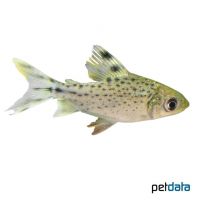Flagtail Characin (Semaprochilodus taeniurus)
| Flagtail Characin Semaprochilodus taeniurus | |
|---|---|
| Name | Flagtail Characin |
| Name Lat. | Semaprochilodus taeniurus |
| Synonym | Curimatus taeniurus |
| Family | Flannel-mouth Characins |
| Family lat. | Prochilodontidae |
| Order | Characins |
| Order lat. | Characiformes |
| Origin | Brazil |
| Habitat | Tributaries, streams, lakes |
| Diet | Omnivore |
| pH | 5.5-7.5 |
| Behavior | Semi-aggressive |
| Keeping | Individual, group |
| Care Level | Moderate |
| Reproduction | Egg scatterer |
| Breeding | None reported |
| Life Span | 5-8 years |
| Protection | No |
| Metric Units | |
| Size | 25-30 cm |
| Temperature | 23-29 °C |
| Hardness | 10-20 °dH |
| Aquarium | 500 l |
| US Units | |
| Size | 10"-12" |
| Temperature | 73-84 °F |
| Hardness | 178-356 ppm |
| Aquarium | 130 gal |
Distribution and habitat
The range of the Tail Striped Night Tetra is the Amazon Basin in Brazil, where they live in rivers and tributaries, as well as in lakes, ponds, and floodplains with dense underwater vegetation.
Maintenance
The aquarium should provide sufficient swimming space and be structured with roots and driftwood. A dark, sandy substrate covered with some foliage (e.g. sea almond leaves) and shaded light is ideal.
No ammonia, ammonium and nitrite should be detectable, the nitrate value should not exceed 100 mg/l. To ensure the water quality and oxygen content, a filter and heater adapted to the aquarium size is required, as well as lighting for the species-appropriate day-night rhythm of the animals.
Diet
In the wild, they feed primarily on plants and detritus. The diet consists mainly of plant food, such as over-scalded leafy and wild vegetables, crushed peas and zucchini or commercial algae leaves and high-quality dry food (flakes, granules) with high plant content (spirulina, kelp), occasionally supplemented with live or frozen cyclops, mosquito larvae, etc. It is recommended to feed small portions several times a day.
Only as much should be fed as is eaten immediately (in a maximum of 10 minutes). A regular and varied diet promotes health and increases resistance
Behaviour and compatibility
They should be kept singly or in a group of at least 5. The fish often behave intra-species aggressive if kept in too small groups. They can be well socialized with other larger fish, such as peaceful cichlids, catfish or knifefish.
Basically, only compatible fish species with similar demands on water condition and water temperature should be socialized.
Sex dimorphism
No external distinguishing characteristics are known. Males are somewhat slimmer than the more rounded appearing females.
Reproduction and breeding
There are no known reports of successful breeding in the aquarium. During the rainy season, they often migrate in large schools several hundred kilometers upstream to spawn in sediment-rich waters. Afterwards the eggs or larvae drift downstream into the nutrient-rich floodplains.
Important
Plants in the aquarium are considered food. The fish have a mouth that can be expanded into a kind of suction disc to pick up mud from the bottom and digest the food (detritus) in it with their second stomach. Since they can jump well, it is necessary to provide a good cover for the aquarium
The well-being of the fish should be checked regularly. Temperature should be checked daily, pH, hardness and nitrate levels at least every 14 days. Regular partial water changes are recommended, even if the contaminant level has not yet reached the upper limit. Sudden changes in water quality should be avoided. Newly introduced fish must be accustomed slowly to the water in the aquarium.
Further literature can be found in your pet store.
References
Text: Werner Winter; Image: petdata
Source: BMELV (1998): Tierschutzgutachten - Haltung von Zierfischen (Süßwasser); RIEHL & BAENSCH (2006): Aquarien Atlas Bd. 3, Mergus Verlag; ENGELMANN (2005): Zootierhaltung - Tiere in menschlicher Obhut: Fische, Verlag Harri Deutsch
- Gemäß § 21 Abs. 5 Tierschutzgesetz idgF
